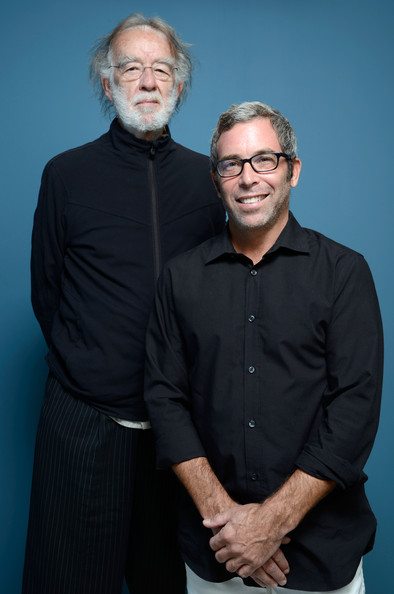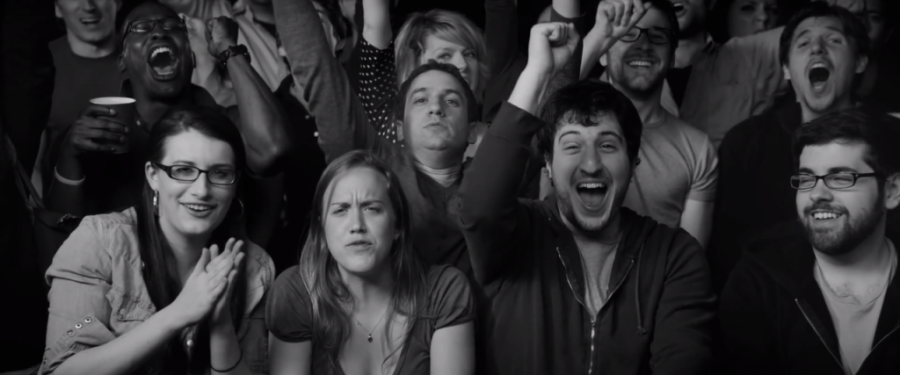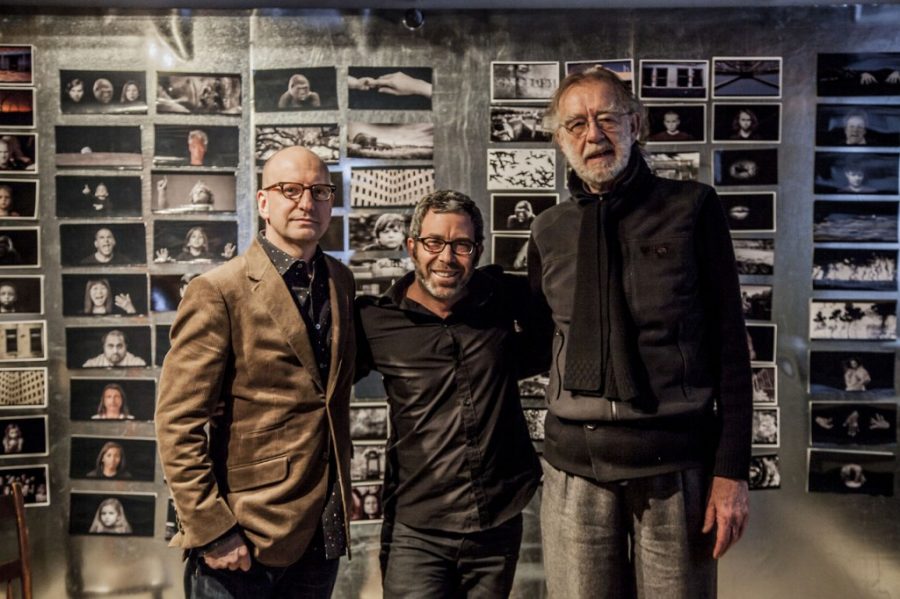
 Godfrey Reggio is a cinema legend. His 1982 film "Koyaanisqatsi" is a landmark of movie history, blending expertly shot images with a terrific score by composer Phillip Glass. Reggio made two more "Qatsi" films - "Powaqqatsi" and "Naqoyqatsi" - with the latter premiering in 2002. Though the Qatsi Trilogy had ended, Reggio was not done with his unconventional career. Teaming with Jon Kane - an editor he met on "Naqoyqatsi" - Reggio returns after more than a decade with "Visitors", another wordless visual poem that is sure to divide audiences.
Godfrey Reggio is a cinema legend. His 1982 film "Koyaanisqatsi" is a landmark of movie history, blending expertly shot images with a terrific score by composer Phillip Glass. Reggio made two more "Qatsi" films - "Powaqqatsi" and "Naqoyqatsi" - with the latter premiering in 2002. Though the Qatsi Trilogy had ended, Reggio was not done with his unconventional career. Teaming with Jon Kane - an editor he met on "Naqoyqatsi" - Reggio returns after more than a decade with "Visitors", another wordless visual poem that is sure to divide audiences.
I sat down with Reggio and Kane to discuss their new, thought-provoking film.
StageBuddy: This is your second collaboration, your first dating back to "Naqoyqatsi" in 2002. What took so long to get together again? What happened in those 10 years before "Visitors" finally happened?
Godfrey Reggio: Well, you know, it's the situation of getting a backer for something like this. You can't go to the industry because how can you explain something that you don't know what the outcome is going to be until you do it? In the industry, you have to have a screenplay that predicates what the film is going to be so it can be seen, so they can plug in all the details. Here, you are asking someone to trust you. People don't want to trust you with money, so we have to look for angels - people who are looking to make a bad deal for love of the project. People who are looking to burn their money, basically, and it takes forever to find those people
SB: When did you decide that you wanted to do another movie together?
GR: Right after when "Naqoy" started. I brought in three editors. Since it was happening at 9/11...
Jon Kane: I was one of three.
GR: Jon was one of the three editors, and the other one was a gentleman from Prague, a real close friend of mine and genius kind of filmmaker, Miroslav [Janek], but after 9/11 his wife was freaking out, she didn't want him in the city because it was going to blow up, so he had to go home. And I had another filmmaker, I won't mention his name because he's a sweetheart, who I admired greatly, who I was actually talking to before Jon for insight, and I hired him but I realized that he really wasn't making the film that I wanted to. He was completely into his own film, which he was doing on the side, which is fine, so I had to whack him and ask him to leave. And Jon I was super pleased with. I can collaborate with Jon. He also is technically beyond efficient, kind of a genius guy in technology, but more than that - there are a lot of people that are very good at technology - he was sensitive to the world around him and was able to absorb what I was saying and help me realize it because I can't do what I'm feeling. I need other people to realize that. I don't use a machine. This is the extent of my technology, this old person's phone [reaches for his outdated cell phone]. To work with Jon was a blessing for me and I was very pleased after "Naqoy", and I told Jon if I get another project, I want to come do this, and of course it took a while to do that. But he stayed with the idea and then he offered me his studio in Red Hook, and I said "Red Hook? Where's that?" Then I found out it was the most dangerous place in Manhattan and I said "Jesus, you're crazy". Then I went out to visit it and I fell in love with it immediately. It was like being on another planet from Manhattan and it was such a relief. And we paid for that studio what you would pay for a toilet in Manhattan. And you're isolated, you don't hear the subway, you don't feel it, you don't hear the sounds of the city. You're in a very remote, creative space and I have him to thank for that.
JK: Yeah well that also gets to that the process of making these films is different than most films. We lived together like a family for pretty much the entire process from the shooting all the way through the post-production. So the environment that we're working in is very important. And "Naqoy's" custom studio was built on Canal St where Godfrey can live and I was running there everyday from Park Slope, 12 miles a day, so there was a shower there for me, there was a chef, but for a reason. We spend all of our time together creating this massive work of art. It's not something you can just do in a week or two. So the environment is very important and the Red Hook studio we sold the idea of having a chef, so we'd have somebody to cook; there's a fireplace, dogs, it's comfortable, we've got a big screen, and we basically camped there for two years to make this happen.
 SB: And for you [Kane], what's the pressure of working with someone like Godfrey, who was already a legend in in 1982?
SB: And for you [Kane], what's the pressure of working with someone like Godfrey, who was already a legend in in 1982?
JK: "Koyaanisqatsi" changed my life completely. I saw it as a Freshman in college, I was a pre-Law major, and after I saw the movie I changed my major completely. So 20 years later, through happenstance and a NY TImes article and a friend of mine and a bunch of things, I got introduced to Godfrey as a potential person to work on "Naqoyqatsi". So I would say the only time I was nervous or intimidated in that way was the first time we met at Philip Glass' house, because I was like "I'm going to meet Godfrey Reggio? Are you kidding me?" But I think a reason that we're still working together is probably five minutes into that get together, at least for me and I think it happened for Godfrey too, I was totally comfortable with Godfrey. I don't know, we had some kind of synergy that happened kind of immediately. So it's not about - I feel very thankful and very honored and lucky to work with Godfrey - but you don't feel like that every
GR: And I feel the same about him, believe me.
JK: So we got passed all that and the reason we can make these things together is that, to do this you have to, the criteria for the work at all times, as much as humanly possible, is the work. It's not "Is it my idea?", "Is it your idea?", "Oh I should listen to him because he's Godfrey Reggio" or "He should listen to me because I know more about a computer than he does", at the end of the day it's about what we're making together. And there's always that you have to get to the point where you can fight and struggle with a person free of bias having to do with that he's a legend that this, that, or the other, so I think we got passed all that very quickly.
SB: So how do you go about planning a movie like "Visitors" that doesn't have a traditional narrative?
GR: I write what's called a "talking paper", and I write it principally for myself so that I can get it out on a piece of paper. It's not a screenplay because these films are not based in literature or text. They are about texture more than that. But having said that, these words become like trigger lines. The film starts with a feeling or an emotion or a perception. I look at it as the aesthetic triplets of sensation, emotion, and perception. That's where they start. I try in a way to act as a midwife to get that out of myself onto some kind of paper. Those words as I say become trigger lines and they become not a script that everyone can read, but a guide that is usually many pages that can guide a discussion as a way to get started. It's all really to get us onto the page of shooting, because since it's pictoral composition, until you have the image, then you're just talking words, so once it's shot, all the preperation goes into what the subject matter is; What are the locations? What camera speeds are you going to shoot at? What lenses are you going to use? Whether the camera is going to be still or in motion, all of those questions become major. But once it's done, you get to see the mistakes you've made, so you don't want to do that again. Or you get to see gee whiz this reveals something I never though was possible. So it's all about a process of...
JK: Sculpting.
GR: Sculpting it and once that stuff is shot we throw the words out pretty much, but we're still left with a form. I always work in a form of three, for what reason, I'm not sure. And then it al gets put together. And it's not just Jon and I and Phillip, it's the whole crew that has access to the mainframe, to the person that works in the kitchen to the guy that drives the car.
JK: That said, the structure of the film is set out before we shoot. The basic buckets that we put the various hoppers of material into, are set beforehand, and like Godfrey said he works in a symphony in three movements. So the music, also, Phillip needs to know the basic structure, so there's an intro, three movements, and an epilogue. And when we started there were also some little tissues between the movements that we got rid of later. But when we go to shoot, I think one of the things that's surprising to people about a film like this is that it's not just something where we shoot a bunch of stuff and then we're like "ah we'll figure it out in the editing room". We do figure out a lot of things in the editing room, but we shot a lot of footage, I think our ratio was...
GR: It was about 65 to 1. No it was more than that because that's based on 10,000 feet. This was 8,700 feet. We shot over 630,000 equivalent feet, but it's digital.
JK: Weeks and weeks worth of footage to watch, but we didn't shoot... there were no categories of imagery that we went to get that we didn't use. In other words, we didn't just shoot a bunch of stuff and decide later on. We shot, for example, with this shot we're looking at here, [points to clip from Visitors projected on screen], this is what we call the "Mass Man" shot. This day of shooting, because we're shooting at 300 fps, and blah blah blah, there was a lot of footage, but we didn't shoot anything other than this for this section of the film. We didn't shoot things that we discarded because we didn't like the idea anymore. So it's a free for all edit. The things that were supposed to go in movement one at the beginning ended up in movement one. In fact, before we edited we were able to basically organze the material by basically having a still frame of each of the type of shots, and just see how the flow was going and see if by chance if we wanted to move some categories of footage from one movement to the other, which we really didn't end up doing.
 SB: Can you talk a little about how integral Steven Soderbergh was to getting this movie out there?
SB: Can you talk a little about how integral Steven Soderbergh was to getting this movie out there?
GR: First of all, he was the presenter and the guy that organized all the financing for "Naqoyqatsi". He made a big effort to get some money for the next film, but the only money that those companies that he asked to put would give us a doc amount of money, but I didn't want to shoot a doc. I wanted to shoot something that was a much more involved, let's say photographically, and it takes time and money and crew. So when the film was just about finished I invited Steven to come over to the studio in Red Hook and after seeing the film he had a very strong response to it, and remarkably Jon and I our producer Larry [Taub] were in the office and he said "Look I want to do anything, everything possible to make this seen, to give it an opportunity to be seen by the public. So his involvement really is to help bring this film to the real world, and because he's Steven Soderbergh - I mean like Francis Coppola or George Lucas - Steven Soderbergh is as ubiquitous as Mickey Mouse and Donald Duck, he's the known introducing the unknown. If he calls the director of the Toronto Film Festival, the director picks up the phone. If I call they say "who's calling? Who? Who are you?" So he used his influence, not just letting us use his name, he's been driving the bus, as it were with distribution. In fact in this room, we've been meeting regularly before the film was finished with people from CAMI, which is Columbia Artist Management Inc, which is probably the most important booker of symphony and big time events all over the planet. They were here, Cinedigm, of course was here, people from Canada were here. All the people that were involved in the distribution of the film, Steven is the chairman of the board for that, and when he speaks, they listen. I couldn't be more happy to have him championing this film.
ND: That's a good guy to have in your corner.
GR: A good guy, because that opens up doors. No question about it.
SB: A recurring theme across all of your movies has been human relationships with technology and our furthering away from nature. Do you really feel that it's a negative relationship? Is it getting worse since the Qatsi trilogy ended?
GR: Well that's a very good question. It's because technology is seen as this thing [my iPad] and that thing [his phone] and that thing [projector], we tend to see it among many things like the economy, like religion, like social behavior, technology is another category. You can look at it from another completely different point of view: technology is not something we use, it's not the use or misuse that determines it's value. From my point of view and others, it's the new environment of life, being so human and animal we become the environment we live in. You have in your body, I have in mine, everyone out here, we have elements in our body that didn't exist 100 years ago. Trace metals that have been created. We are like a litmus of the environment we live in. That's why it's not so crazy to see how we could look like gorillas and monkeys and how the roach we share you know, what, 89% of the same genetic structure as the roach? It's amazing. We become the environment we live in. We are now becoming cyborged, not of science fiction, but the fiction of science, because we keep seeing technology as just another category of life, like everything else. It's not the effect of technology on the environment, on the economy, on war, it's that everything is situated in technology becomes the new comprehensive host of life. Like a natural environment, but we don't live in the natural environment, we predate on it. We use it to inflate this synthetic world we live in which is technology. Is it getting better? It's getting, not better - we're in a period of such incredible accelaration that we are outrunning our future. We're living in a routed future as well where you could tell right now what the future is going to be by virtue of what we're not looking at. So technology is so present to us that because of it's presence, it's hidden in plain sight. It's not observable because it's normal, ordinary, it's familiar. It's a familiar that we least see. So we take it all for granted without seeing anything weird about it. If there's anyone left 1000 years from now, they're going to look back at us and say "What were those people eating? What were they on? Where were they? What were they doing?" So for me it's an unspeakable tragedy. It's the price we pay for the pursuit of our technology happiness is plummeting the whole planet right now. It's eliminating the animals, the fish, opceans are heating up. You can put a band aid on it and say I'm being pessimistic, but I do feel, I can't insist on it but at least I cast my own shadow so I have my own thought.
"Visitors" opens in limited release on January 24th in NYC.